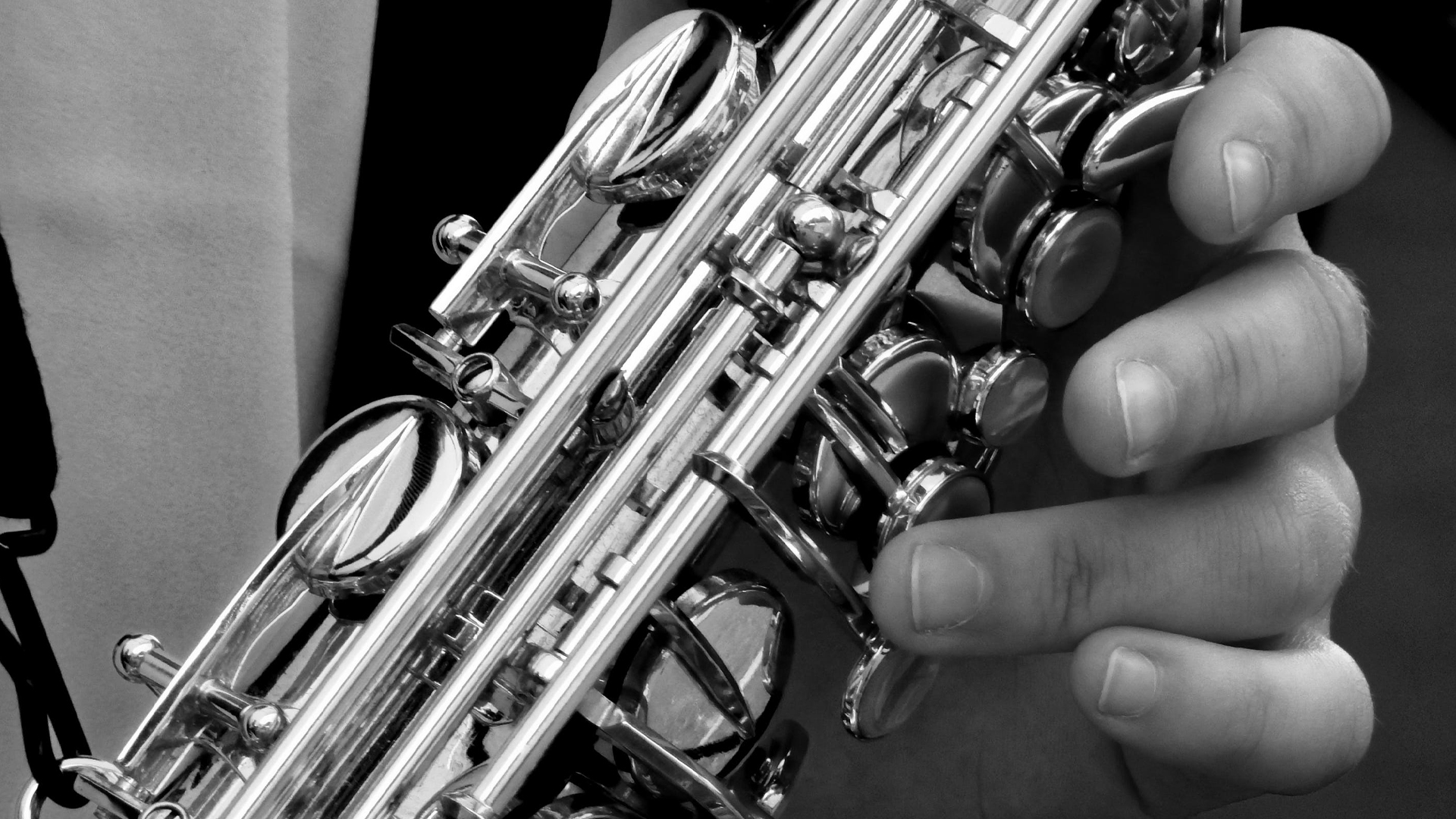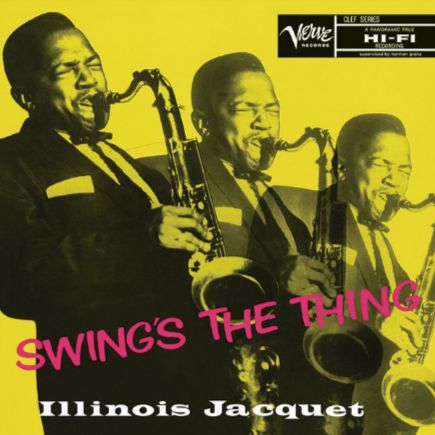Illinois Jacquet, le souffle flamboyant du ténor jazz
Figure marquante du jazz des années 1940, Illinois Jacquet s’impose comme l’un des pionniers du saxophone ténor au style percutant, situé à la croisée du swing et du rhythm and blues naissant. Né en Louisiane en 1922 d’une mère d’origine sioux et d’un père créole, il grandit au Texas, où il s’imprègne des orchestres de danse avant d’intégrer très jeune la scène professionnelle. Son jeu impétueux, à la fois lyrique et incandescent, amorce un tournant décisif dans l’évolution du saxophone jazz.
C’est à seulement 19 ans que Jacquet accède à la célébrité grâce à son solo fulgurant sur Flying Home, enregistré en 1942 avec l’orchestre de Lionel Hampton. Ce chorus d’une intensité rare, où les cris du ténor se mêlent à une énergie brute et jubilatoire, devient une référence absolue du style honking, considéré comme l’un des précurseurs du rock’n’roll. Ce souffle libéré incarne la vitalité du jazz populaire d’après-guerre: une musique urbaine, dansante, effervescente.
Après son passage chez Lionel Hampton, Illinois Jacquet rejoint successivement les orchestres de Cab Calloway (1943-1944) et de Count Basie (1944-1945), tout en participant au premier concert du Jazz at the Philharmonic en 1944, événement emblématique organisé par Norman Granz, aux côtés de Nat King Cole et d’autres figures majeures du jazz moderne.
Sa virtuosité, son sens du spectacle et sa puissance de projection en font un soliste incontournable. À mi-chemin entre l’élégance harmonique de Coleman Hawkins et l’énergie rugueuse des saxophonistes texans, il forge un style expressif, profondément enraciné dans le blues.
Durant les années 1950, Jacquet multiplie les tournées et devient l’un des ténors les plus sollicités de la scène américaine. En 1993, il est invité à jouer C-Jam Blues à la Maison Blanche lors de la cérémonie d’investiture du président Bill Clinton, symbole de sa reconnaissance institutionnelle. Dans les années 1980, il dirige encore son propre big band, fidèle à l’esthétique des grandes formations swing, qu’il défend avec ferveur jusqu’à la fin de sa carrière.
Illinois Jacquet, el soplo ardiente del saxo tenor
Illinois Jacquet, saxofonista tenor de estilo impetuoso e inventivo, precursor del estilo honking, marcó decisivamente la transición del swing hacia el rhythm and blues.
Figura destacada del jazz de los años cuarenta, Illinois Jacquet se impuso como uno de los pioneros del saxofón tenor con un estilo contundente, situado en la encrucijada entre el swing y el naciente rhythm and blues. Nacido en Luisiana en 1922, de madre siux y padre criollo, creció en Texas, donde se empapó de los sonidos de las orquestas de baile antes de incorporarse muy joven a la escena profesional. Su manera de tocar, a la vez lírica e incandescente, marcó un punto de inflexión en la evolución del saxofón dentro del jazz.
Jacquet alcanzó la fama con solo 19 años, gracias a su solo fulgurante en Flying Home, grabado en 1942 con la orquesta de Lionel Hampton. Este solo, de una intensidad inusual, mezcla gritos del tenor con una energía cruda y jubilosa, convirtiéndose en una referencia absoluta del estilo honking, considerado como uno de los antecedentes directos del rock’n’roll. Ese soplo liberado encarna la vitalidad del jazz popular de la posguerra: una música urbana, bailable y efervescente.
Tras su paso por la orquesta de Hampton, Illinois Jacquet se unió sucesivamente a las formaciones de Cab Calloway (1943-1944) y de Count Basie (1944-1945), y participó además en el primer concierto del Jazz at the Philharmonic en 1944, un evento emblemático organizado por Norman Granz, junto a Nat King Cole y otras figuras destacadas del jazz moderno.
Su virtuosismo, su sentido del espectáculo y su fuerza expresiva lo convirtieron en un solista imprescindible. A medio camino entre la elegancia armónica de Coleman Hawkins y la energía áspera de los saxofonistas texanos, desarrolló un estilo expresivo, profundamente impregnado de blues.
Durante los años cincuenta, Jacquet realizó numerosas giras y se consolidó como uno de los tenores más solicitados del panorama estadounidense. En 1993, fue invitado a tocar C-Jam Blues en la Casa Blanca durante la ceremonia de investidura del presidente Bill Clinton, símbolo de su reconocimiento institucional. En los años ochenta dirigió aún su propia big band, fiel al espíritu de las grandes formaciones swing, que defendió con entusiasmo hasta el final de su carrera.
Illinois Jacquet, il soffio infuocato del tenore jazz
Illinois Jacquet, sassofonista tenore dal fraseggio impetuoso e inventivo, è stato un precursore dello stile honking e ha segnato la transizione dallo swing al rhythm and blues.
Figura di rilievo del jazz degli anni Quaranta, Illinois Jacquet si affermò come uno dei pionieri del sassofono tenore grazie a un suono potente, situato al crocevia tra lo swing e il nascente rhythm and blues. Nato in Louisiana nel 1922 da madre sioux e padre creolo, crebbe in Texas, dove si immerse nel mondo delle orchestre da ballo prima di entrare giovanissimo nel circuito professionale. Il suo stile, al tempo stesso lirico e incandescente, rappresenta una svolta nell’evoluzione del sassofono nel jazz.
Jacquet raggiunse la fama a soli 19 anni grazie al suo assolo travolgente in Flying Home, registrato nel 1942 con l’orchestra di Lionel Hampton. Questo chorus, di rara intensità, in cui i suoni urlati del tenore si fondono con un’energia grezza e gioiosa, divenne un modello assoluto dello stile honking, considerato tra le radici dirette del rock’n’roll. Quel soffio liberato incarnava la vitalità del jazz popolare del dopoguerra: una musica urbana, danzante, effervescente.
Dopo l’esperienza con Hampton, Illinois Jacquet suonò con le orchestre di Cab Calloway (1943-1944) e Count Basie (1944-1945), e partecipò al primo concerto dello Jazz at the Philharmonic nel 1944, evento emblematico organizzato da Norman Granz, accanto a Nat King Cole e ad altri protagonisti del jazz moderno.
La sua tecnica, la sua presenza scenica e la forza del suo suono ne fecero un solista imprescindibile. A metà strada tra l’eleganza armonica di Coleman Hawkins e la grinta dei sassofonisti texani, Jacquet sviluppò uno stile espressivo, profondamente intriso di blues.
Negli anni Cinquanta, fu molto richiesto e intraprese numerose tournée. Nel 1993, fu invitato a eseguire C-Jam Blues alla Casa Bianca durante la cerimonia di insediamento del presidente Bill Clinton, gesto simbolico di un riconoscimento ufficiale. Ancora negli anni Ottanta, Jacquet guidava la sua big band, fedele all’estetica delle grandi formazioni swing, che continuò a difendere con passione fino al termine della sua carriera.
Illinois Jacquet, the blazing breath of the jazz tenor
Illinois Jacquet, a tenor saxophonist with a fiery and inventive style, was a pioneer of the honking sound and played a key role in the transition from swing to rhythm and blues.
A major figure in 1940s jazz, Illinois Jacquet emerged as one of the trailblazers of the tenor saxophone, with a bold approach that bridged the swing era and the birth of rhythm and blues. Born in Louisiana in 1922 to a Sioux mother and a Creole father, he grew up in Texas, where he absorbed the vibrant atmosphere of dance orchestras before entering the professional scene at a very young age. His impassioned playing—both lyrical and incendiary—marked a turning point in the evolution of jazz saxophone.
At just 19 years old, Jacquet rose to fame with his electrifying solo on Flying Home, recorded in 1942 with Lionel Hampton’s orchestra. That intense chorus, blending shouted phrases and raw, jubilant energy, became an iconic example of the honking style, often cited as one of the direct precursors of rock ’n’ roll. His unleashed tenor sound captured the vitality of postwar popular jazz: urban, danceable, and effervescent.
After his stint with Hampton, Illinois Jacquet went on to join the orchestras of Cab Calloway (1943–1944) and Count Basie (1944–1945). He also performed in the first Jazz at the Philharmonic concert in 1944, an emblematic event produced by Norman Granz, sharing the stage with Nat King Cole and other leading figures of modern jazz.
With his virtuosity, charisma, and powerful projection, Jacquet became a standout soloist. Somewhere between the harmonic elegance of Coleman Hawkins and the raw energy of the Texas tenor tradition, he crafted an expressive style deeply rooted in the blues.
Throughout the 1950s, he toured extensively and became one of the most in-demand tenors in the American jazz scene. In 1993, he was invited to perform C-Jam Blues at the White House for President Bill Clinton’s inauguration ceremony—a powerful symbol of institutional recognition. In the 1980s, he was still leading his own big band, loyal to the spirit of classic swing ensembles, which he continued to champion passionately until the end of his career.


